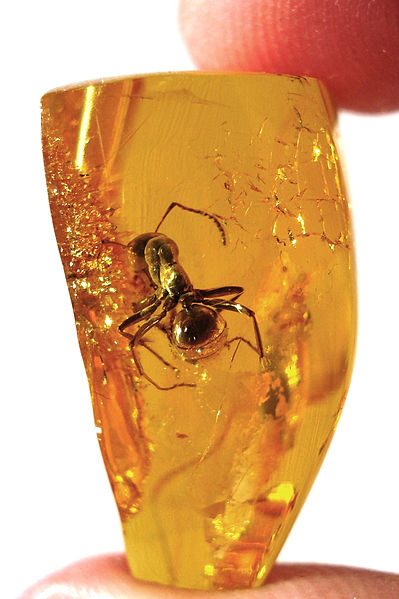Amber has been popular among writers since the B.C. era, so here are some of the most important records concerning amber in Ancient History.
The earliest written record dates from 883 B.C. and was discovered in the geographical zone of Egypt, in obelisk stone carvings. It states that Ashur-Nasir-Apal, an Assyrian ruler, sent his country's people to "the land of amber", a land where seas wash the amber shores "like copper". The inscription is found in the British Museum.
 In what concerns the electric properties of amber, Thales (of Miletus) was the one to first mention them and to compare them with a magnet's attraction force. Aristotle is the first to highlight explicitly the resinous origins of amber. He also detailed amber and natural magnetic experiments in 600 B.C. and believed, just like Anaxagoras, that amber is made of soul. In 32 B.C., Theophrastus also experimented with amber.
In what concerns the electric properties of amber, Thales (of Miletus) was the one to first mention them and to compare them with a magnet's attraction force. Aristotle is the first to highlight explicitly the resinous origins of amber. He also detailed amber and natural magnetic experiments in 600 B.C. and believed, just like Anaxagoras, that amber is made of soul. In 32 B.C., Theophrastus also experimented with amber.
Moving on to other examples of amber in Ancient History, the following civilizations found great significance in amber: Assyrians and Egyptians, Greeks and Romans, Phoenicians and Etruscans. Legends in Ovid mention the story of when Phaeton, the son of the Sun god Phoebus, convinced his father to let him drive the Sun's chariot. But one day he drove it across the sky too close to Earth and the chariot was set on fire. In order to save the world, Jupiter struck Phaeton, who was hit out of the sky with thunderbolts and died. His mother and sisters were turned into trees because of their grief and their tears were dried by the sun into amber pieces.
Other ancient writers, such as Nicias, believed that amber is the very essence of the setting sun. In his writings, amber was congealed in the seas and washed up on the shores. The electrical properties of the stone gave it other names. For example, amber in the Ancient History of Greece is recorded as "Elektra". The ancient poet Homer also used amber as an inspiration in his writing. To be precise, he was probably thinking about it when describing "a brilliant electron" on the shields of his heroic characters. The Greek traveler called Pytheus of Massilia is the first to describe washed-ashore amber that was later on found by natives and sold to the Teutons. The latter delivered it to Gallia and later on to its final destination: Massilia. Pytheus traveled in ancient times from the Mediterranean Sea all the way to the Scandinavian coasts.
 Euripides (480-406 B.C.) was a leading Greek figure in drama and an important disciple of the sophists who frequently mentioned various amber features, including the fact that the gemstone has a transparent gleam. Plato (427-347 B.C.), who was an outstanding philosopher, also gained an interest in amber and analyzed the similarities between amber and magnetic properties, described in Timaeus, one of his famous works. Another great Greek philosopher, Aristotle (384-322 B.C.) was the one to launch valuable ideas concerning the origin of amber. He also mentioned a resinous origin of amber in the Meteorologica treatise. This happened in an interesting circle of events: Aristotle's methodological start to the study of nature was of course physiology and the exploration of emergence of life, evolution and the decay process of a natural body, along with all of nature's laws. He proved that amber was nothing more than hardened tree resin.
Euripides (480-406 B.C.) was a leading Greek figure in drama and an important disciple of the sophists who frequently mentioned various amber features, including the fact that the gemstone has a transparent gleam. Plato (427-347 B.C.), who was an outstanding philosopher, also gained an interest in amber and analyzed the similarities between amber and magnetic properties, described in Timaeus, one of his famous works. Another great Greek philosopher, Aristotle (384-322 B.C.) was the one to launch valuable ideas concerning the origin of amber. He also mentioned a resinous origin of amber in the Meteorologica treatise. This happened in an interesting circle of events: Aristotle's methodological start to the study of nature was of course physiology and the exploration of emergence of life, evolution and the decay process of a natural body, along with all of nature's laws. He proved that amber was nothing more than hardened tree resin.
It is notable how amber in Ancient History was the center of attention in writings, experiments and philosophies. For example, Pausanias, a Greek author and traveler from the 2nd century B.C., was fascinated with the description of a great number of Greek cultural monuments, extremely famous at that time. He also mentioned in his work how rare amber is, how valuable it becomes to people and how fascinating it is in comparison with different metal electrons such as gold and silver alloy.
Arabian scientists such as Al Rasius (864-925) and Ibn Sina (980-1037) made good use of the pieces of information gathered up by the ancient authors and included them in the presentation of new medical recipes, such as advice on how to clean an eye after a blade gets in it with the help of a rubbed plate of amber.
It is fascinating to see how often there are mentions of amber in Ancient History and how much significance this stone had in medical recipes, writings, experiments and everyday life.
Comments
No posts found



